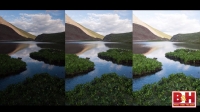Learn how to use HDR to create natural looking photos in this B&H educational video
posted Wednesday, July 23, 2014 at 1:13 PM EST

When photographing a scene with strong contrast, such as a landscape during the morning or evening light, a cityscape in the afternoon, or an interior scene with bright light coming in through the windows, most digital cameras' sensors are uncapable of capturing the full dynamic range of the scene. This leads to a loss of detail either in the highlight or in the shadows.
The most common technique to overcome this natural limit of digital sensors is HDR photography. By taking multiple images of the same scene with varying exposures, these can be merged by software to display the full dynamic range of the scene, with lots of detail visible both in the shadow and highlight areas.
For the beginner in HDR photography, it is often difficult to create HDR images that look pleasing and natural, as it is so easy to overdo the HDR effect and end up with pictures that look over-the-top and starkly unrealistic. When done correctly, however, an HDR photo can mimick the look of a scene as it would've been perceive by the naked eye, and not look like an "HDR" photo at all.
This is exactly what photographer Tim Cooper teaches to do in this episode of B&H Prospectives, a series that features professional photographers sharing their knowledge and technique on various photographic topics. At various examples including landscape scenes and an indoor shoot, Tim walks us though the most important things to keep in mind when doing HDR photography, and explains how to end up with a naturally looking HDR photo.
For a more thorough lesson on HDR photography, B&H also has a full 1 hour 15 minutes video with Tim Cooper in its YouTube channel, which goes much more in depth.
(via PetaPixel)